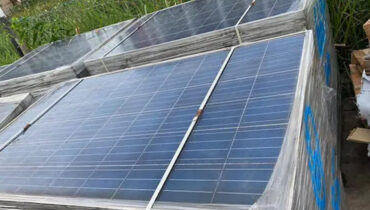Table of Contents
The sun, a boundless source of clean and renewable energy, offers humanity a remarkable opportunity to reduce our reliance on fossil fuels and combat climate change. Two distinct approaches, passive and active solar energy systems, have emerged as key players in the quest for sustainable energy solutions. In this article, we will delve into the fascinating world of passive and active solar energy, exploring their differences, applications, and their pivotal role in ushering in a greener and more environmentally conscious future. Join us on a journey through the realms of harnessing the sun’s energy for a brighter tomorrow.
When it comes to harnessing the incredible power of the sun for various applications, two primary approaches stand out: passive and active solar energy systems. These methods offer sustainable alternatives to traditional sources of energy and play a significant role in mitigating climate change. In this article, we’ll explore the differences between passive and active solar energy, their applications, advantages, and how they contribute to a more sustainable future.
What is Solar Energy?
Solar energy is the radiant energy emitted by the sun, a powerful and sustainable source of light and heat. This energy can be harnessed and converted into various forms, including electricity, to meet a wide range of human needs. Solar panels, also known as photovoltaic cells, are used to capture and convert sunlight into electrical power.
Solar energy is a clean and abundant resource, making it a vital component in the transition to more eco-friendly and sustainable energy sources, contributing significantly to mitigating the effects of climate change and reducing our carbon footprint.
Passive Solar Energy
Passive solar energy is a sustainable approach that harnesses the sun’s natural heat and light without the use of mechanical or electrical systems. This method relies on architectural design and natural processes to provide heating, cooling, and lighting for buildings. It is an environmentally friendly and cost-effective way to improve energy efficiency in structures.
The Basics
Passive solar energy is the art of utilizing the sun’s energy without the need for mechanical or electrical devices. It capitalizes on the natural movement of heat and light. This energy system has been used for centuries, dating back to ancient civilizations.
Applications
- Passive Solar Heating: This method involves designing buildings to maximize natural heat absorption during the winter months. South-facing windows, thermal mass materials, and proper insulation are key components.
- Passive Solar Cooling: Passive cooling aims to keep buildings comfortable during hot summers. Techniques like shading and natural ventilation are employed to reduce indoor temperatures.
Advantages
- Environmentally Friendly: Passive solar energy reduces reliance on non-renewable energy sources, decreasing carbon emissions.
- Cost-Effective: The initial setup costs are often lower than active solar systems, making it a viable option for many homeowners.
- Low Maintenance: With no mechanical components, passive solar systems require minimal maintenance.
Active Solar Energy
Active solar energy is a dynamic approach to harnessing the sun’s power using mechanical and electrical systems. Solar panels, or photovoltaic cells, are employed to capture sunlight and convert it into electricity, making it a versatile source of power for homes, businesses, and more.
Additionally, active solar water heating systems use solar collectors to heat water, reducing the dependence on conventional water heaters and decreasing energy costs. Active solar energy offers efficient energy conversion, energy storage, and is well-suited for various applications, contributing to a more sustainable and greener future.
The Basics
Active solar energy, in contrast to its passive counterpart, relies on mechanical and electrical systems to capture, store, and distribute solar energy. This approach requires the use of solar panels and other active components.
Applications
- Photovoltaic (PV) Systems: Solar panels convert sunlight into electricity, which can power homes, businesses, and even vehicles.
- Solar Water Heating: Active systems use solar collectors to heat water for residential or industrial use.
Advantages
- Efficient Energy Conversion: Active solar systems are highly efficient at converting sunlight into electricity or heat.
- Energy Storage: Excess energy generated can be stored for later use, ensuring a continuous energy supply.
- Wide Range of Applications: Active solar energy can be used in various settings, from homes and commercial buildings to remote locations.
Choosing the Right System
Choosing the right solar energy system depends on several factors. Location plays a crucial role, as the effectiveness of passive and active systems varies with geography and climate. Budget considerations are essential, as passive systems are generally more cost-effective initially, while active systems require a higher upfront investment. Your specific energy needs, such as electricity, hot water, or space heating, will also influence your choice. In many cases, a combination of passive and active solar systems can provide the most efficient and tailored energy solution.
Factors to Consider
Deciding between passive and active solar energy depends on several factors:
- Location: Your geographic location and climate play a crucial role in determining which system is more suitable.
- Budget: Passive solar systems are generally less expensive to install, while active systems require a more substantial initial investment.
- Energy Needs: Consider your energy needs – whether you need electricity, hot water, or space heating.
Complementing Each Other
In many cases, passive and active solar energy systems can complement each other to create a more balanced and efficient energy solution. For instance, a building may incorporate passive solar design elements to provide natural heating and cooling, while active solar panels can generate electricity for the same structure. This combined approach optimizes energy utilization and minimizes the reliance on non-renewable energy sources. The synergy between these systems is essential in achieving sustainability and reducing environmental impact. By integrating both passive and active solar energy, we can work towards a greener and more eco-conscious future.
FAQs
1. What is passive solar energy?
Passive solar energy is a method of using the sun’s natural heat and light to heat or cool buildings without the use of mechanical or electrical devices.
2. How does passive solar heating work?
Passive solar heating works by designing buildings to maximize heat absorption during the winter months, often through south-facing windows and thermal mass materials.
3. What is active solar energy?
Active solar energy relies on mechanical and electrical systems, such as solar panels, to capture, store, and distribute solar energy for various applications.
4. What are photovoltaic (PV) systems in active solar energy?
PV systems use solar panels to convert sunlight into electricity, which can be used to power homes, businesses, and more.
5. How do I decide between passive and active solar energy for my home?
The decision depends on factors like your location, budget, and energy needs. Passive systems are cost-effective, while active systems offer higher efficiency.
6. Can I use both passive and active solar systems in my home?
Yes, many homes use both passive and active systems in tandem to optimize energy efficiency. For example, passive solar design for heating and active solar panels for electricity generation.
Conclusion
In conclusion, the comparison between passive and active solar energy systems underscores the versatility and ingenuity in harnessing the sun’s power for a sustainable future. Passive solar energy, with its simplicity and cost-effectiveness, offers an environmentally friendly means of providing heating and cooling for buildings. Active solar energy, driven by advanced technology, excels in efficient energy conversion and can be applied across diverse sectors, from residential to industrial.
The choice between these systems hinges on geographic location, budget, and energy needs, but a harmonious coexistence of both can yield an optimal solution. As the world pivots towards cleaner, more eco-conscious energy sources, passive and active solar energy stand as beacons of hope, reducing carbon emissions and paving the way for a greener, more sustainable planet. The sun, our boundless energy source, guides us towards a brighter, cleaner future.

